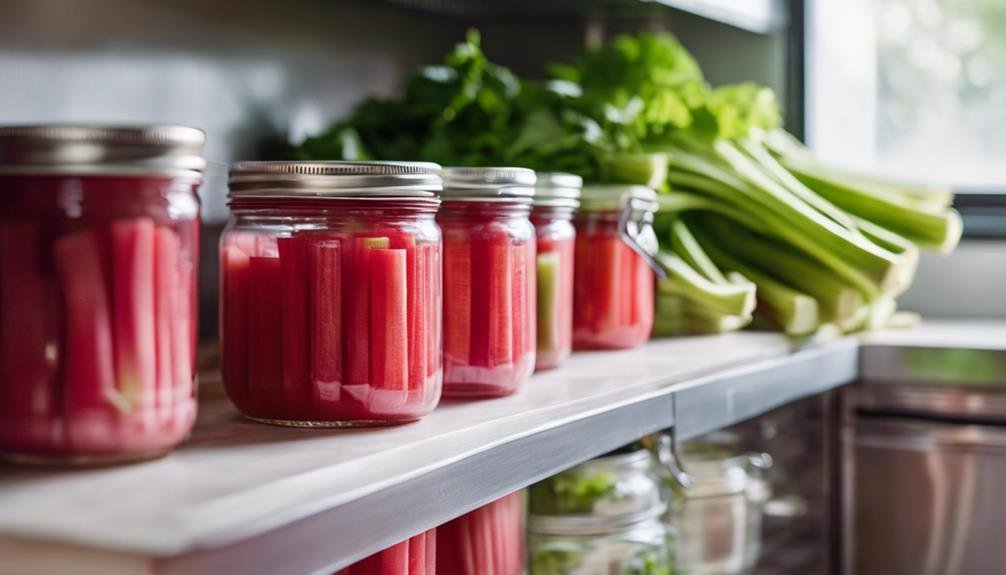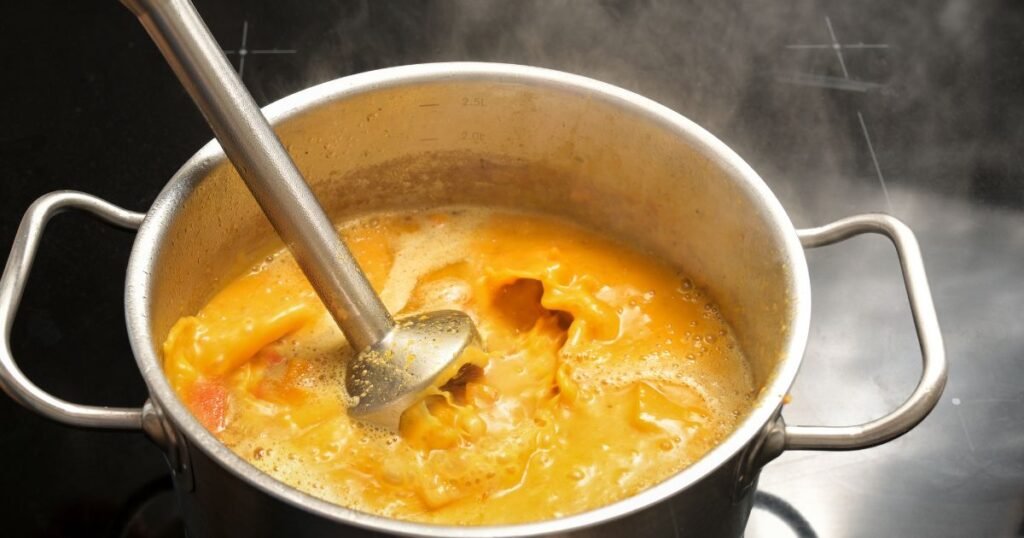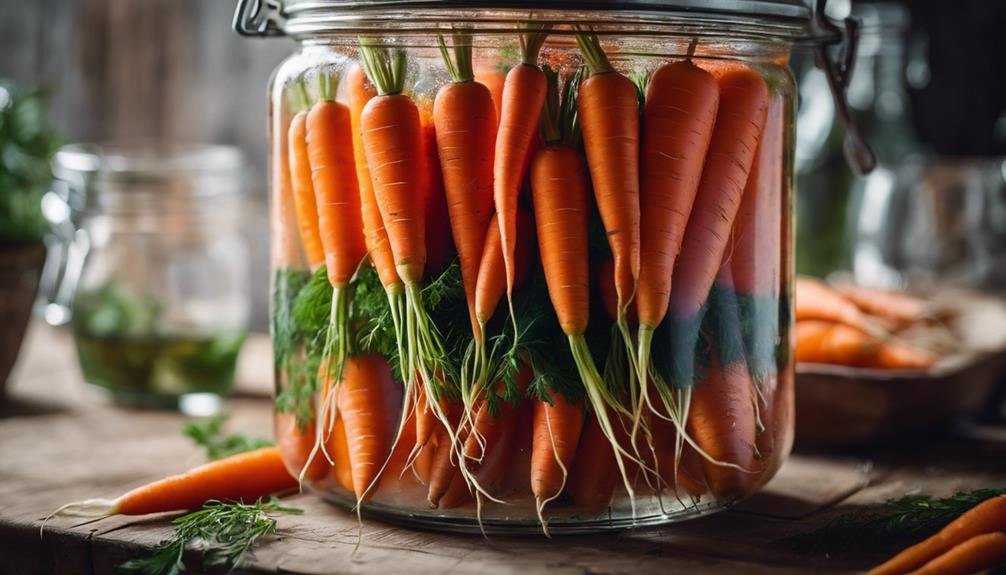Like a fine wine that needs the right cellar to truly shine, your freshly picked rhubarb craves the perfect storage conditions to keep its tangy zest alive.
You’ve got the vision of pies and jams dancing in your head, but you’re in for a sour surprise if you don’t store it right. Luckily, you’ll uncover the secrets to keeping your stalks as crisp and refreshing as a spring morning.
From the fridge to the freezer, we have the lowdown on preventing those brown spots and wilted dreams. But the tale has a twist that could change how you look at rhubarb forever.
Stick around, and you’ll find out just what that is.
Storing Rhubarb Key Takeaways
- Store rhubarb in a sealed plastic bag in the fridge, wrapped in a damp paper towel for optimal freshness.
- Freezing rhubarb after washing, chopping, and quick blanching preserves its flavor and nutrients for long-term use.
- Canning rhubarb involves sterilizing and processing jars in a water bath, ensuring safe preservation and a burst of flavor year-round.
- To revive soft rhubarb stalks, soak them in ice water and remove the leaves before using them in culinary creations to maintain quality.
Signs of Spoilage
How can you tell if your rhubarb has gone bad? If you’re a freedom-loving foodie, there’s nothing more liberating than knowing when to hold ’em and fold ’em in the kitchen.
Initially off, keep an eye out for the tell-tale rhubarb spoilage signs. Like those unsightly brown spots, a color change is your initial red flag. It’s like the rhubarb is waving a little brown flag of surrender, and it’s your cue to take action.
Next, give that stalk a gentle squeeze. If it’s got a soft texture that makes you think of a limp handshake, it’s probably time to say farewell. And the nose knows a rotten smell. If your rhubarb smells off, trust your instincts and steer clear.
But wait, the tale has a twist for those slightly soft stalks! Try a rhubarb ice water revival before you condemn them to the compost. Yes, the revival of immersing them in it. It’s like a spa day for your rhubarb, giving those stalks a chance to redeem themselves and crisp up, ready for your culinary adventures.
Fresh Storage Methods
To keep your rhubarb at its peak, wrap it in a damp paper towel and stash it in the fridge, where it can chill out in the perfect veggie spa conditions of 32 to 40°F. This isn’t just any old storage method; it’s an art form that preserves that tangy freshness and vibrant color we crave in our rhubarb dishes.
To rhubarb fridge storage, think of it as prepping a VIP guest for an exclusive stay. First off, those leaves? They have to go. They’re not only inedible but could speed up the spoilage process. Trim the ends, and you’re on your way to maximizing rhubarb preservation. Slip those ruby-red or green stalks into a sealable plastic bag, ensuring a snug but not suffocating fit. This setup keeps them hydrated without waterlogging, preventing that dreaded rhubarb color from changing to a less appealing brown.
Freezing Techniques

After mastering the art of fridge storage, let’s tackle freezing your rhubarb to ensure its tang and texture last well beyond the season. Freezing rhubarb is like giving it a ticket to the land of eternal spring, and who doesn’t love a bit of culinary time travel?
Initially, wash your stalks to boot out any dirt hitting a ride. Then, chop it up into bite-sized pieces of future delight.
Here’s where it gets cool—literally. Lay those prepped pieces on a baking sheet, not touching, like sunbathers keeping to their towels. This step stops them from turning into an indistinguishable clump. A quick freeze on this sheet, and then, whoosh, into a freezer-safe bag, they go for the long-term storage party.
But wait, there’s a plot twist—blanching rhubarb before this freezer saga can lock in flavor and nutrients. Just a quick dip in boiling water, then an ice bath, and voilà, your rhubarb’s dressed to impress in its freeze-proof armor. This method is the secret handshake of rhubarb preservation, ensuring your stash stays vibrant and tasty. Freeze rhubarb, and you’re not just storing it; you’re capturing a season in every bite.
Canning Essentials
Diving into the world of canning rhubarb, you’ll reveal the secret to savoring its tart glory year-round, ensuring your pantry is stocked with this versatile ingredient for all your culinary adventures. Properly canned rhubarb captures the essence of spring in a jacaranda and guarantees a burst of flavor whenever you decide to crack one open.
Here’s how to keep it fresh, fun, and safe:
- Choose the Right Jars: Only use canning jars designed for the task. These jars aren’t just containers; they’re your ticket to safe preservation and long-term storage success.
- Follow the Recipes: Follow canning recipes like your culinary Bible. Deviation might lead to disaster, which means a pantry devoid of rhubarb delights.
- Understand the Process: Canning isn’t just cooking; it’s a ritual. Every step, from sterilizing your jars to processing them in a water bath, is a dance towards deliciously canned rhubarb.
- Store Wisely: Once properly canned, stash your rhubarb treasure in a cool, dark place. Here, it’ll sit patiently, waiting to add pizzazz to your pies, jams, and sauces, proving that good things come to those who can.
Reveal the freedom of flavors with these canning essentials, and let your culinary flag fly high with rhubarb all year round!
Usage Ideas

Exploring the myriad ways to incorporate rhubarb into your culinary repertoire, you’ll realize it’s not just for pies anymore. From tangy cocktails to savory delights, rhubarb’s versatility is boundless. Remember to remove those leaves initially, as they’re not part of your culinary adventure. Stash your rhubarb in the refrigerator or learn how to freeze rhubarb for long-term storage, ensuring you’ve always got some on hand for when creativity strikes.
| Dish Type | Why It’ll Rock Your World |
|---|---|
| Strawberry Rhubarb Crisp | A classic that marries sweet and tart in a symphony of flavors. |
| Rhubarb Ginger Fizz | Refresh your spirit with this zesty, sparkling concoction. |
| Rhubarb Muffins | Breakfast with a twist, adding a tangy kick to your morning routine. |
| Savory Rhubarb Sauce | Lift your meat dishes with a sauce that’s as bold as you are. |
| Rhubarb Smoothie | Revolutionize your wellness game with a sip of vitamin-packed goodness. |
Delve into these rhubarb recipes, and you’ll soon see why this vegetable (yes, it’s technically a vegetable!) deserves a spotlight in your kitchen. Whether it’s fresh or frozen, rhubarb is a game-changer, ready to add a zing to your meals and snacks.
Frequently Asked Questions
Can You Freeze Fresh Rhubarb Raw?
Fresh rhubarb can be frozen raw. Washh, chop, and place it directly in the freezer. This process, which requires no blanching, effectively preserves its flavor and texture for future use in various recipes.
Do You Add Sugar When Freezing Rhubarb?
Adding sugar when freezing rhubarb is recommended. This process enhances the flavor, preserves the texture, and helps to prevent freezer burn. Sprinkling the appropriate amount of sugar before freezing ensures delicious outcomes for your future recipes.
Is Frozen Rhubarb as Good as Fresh?
When properly handled, frozen rhubarb is nearly as good as fresh. It retains flavor and nutrients, making it ideal for pies and jams. However, anticipate a softer texture upon thawing. Therefore, the substitution is generally acceptable.
What Is the Average Shelf Life of Rhubarb?
When kept in the refrigerator, rhubarb has an average shelf life of 1-2 weeks. To maximize this duration, store it in a sealed bag. For maximum flavor, fresh rhubarb is preferable to frozen.
Conclusion
So, you’ve become a rhubarb wizard, mastering the art of keeping those tangy stalks fresh and flavorful.
Remember, it’s time to bid farewell if it’s sporting brown spots or whiffs of yuck. Stash it in the fridge snug in a plastic bag, or give it a chilly nap in the freezer after a quick blanch.
Got too much? Can it whip up some rhubarb delights more often? Waste not; taste a lot—your rhubarb adventures are just beginning!


